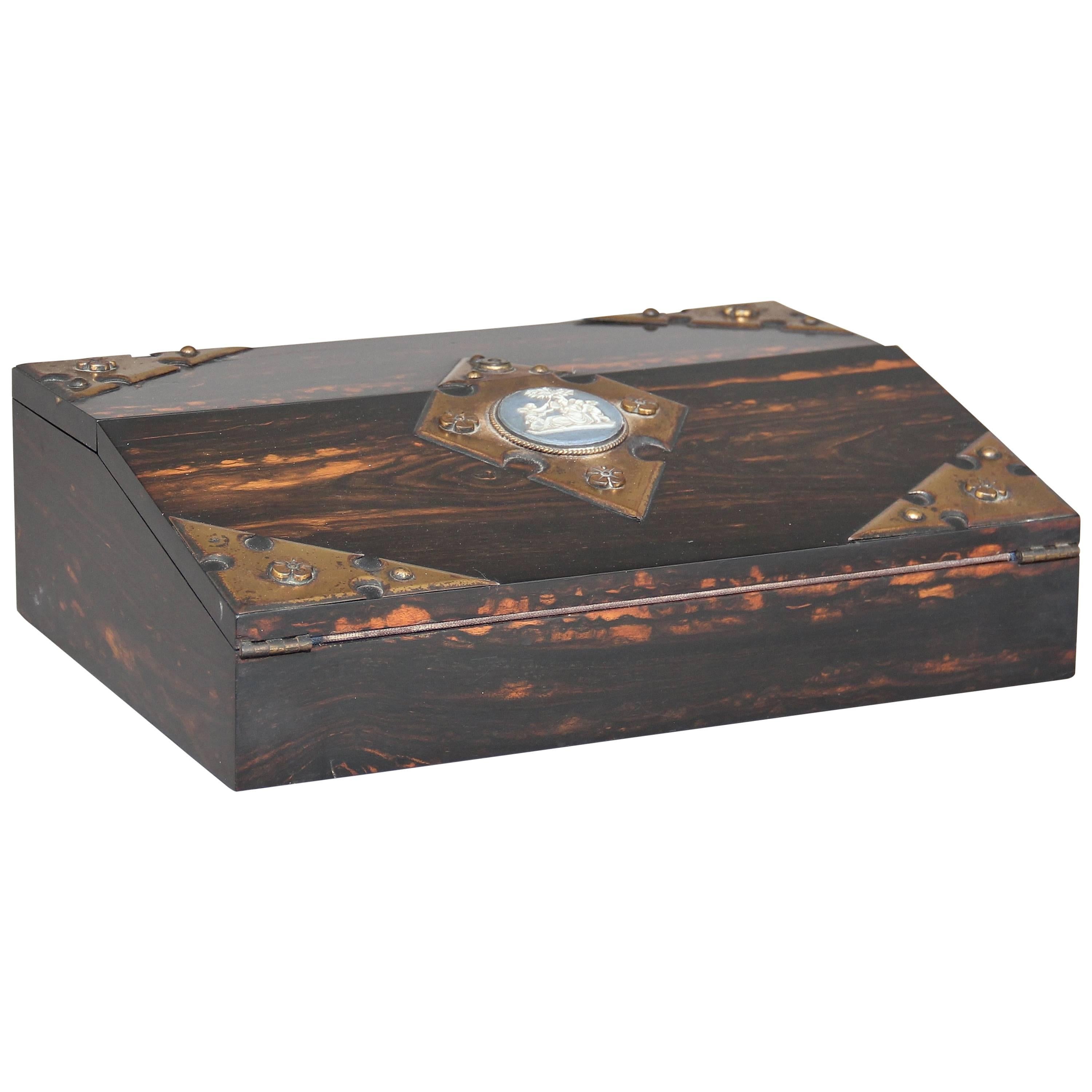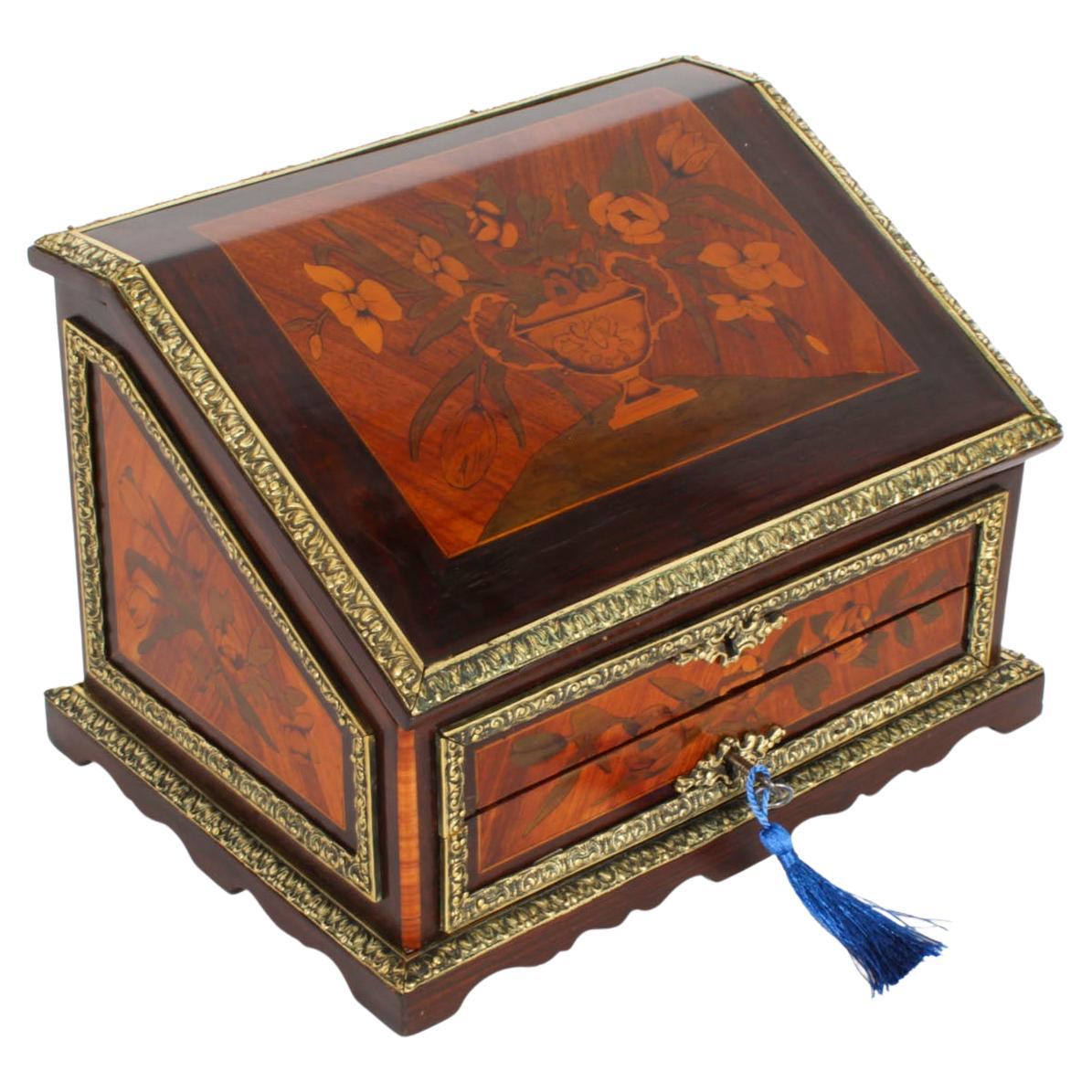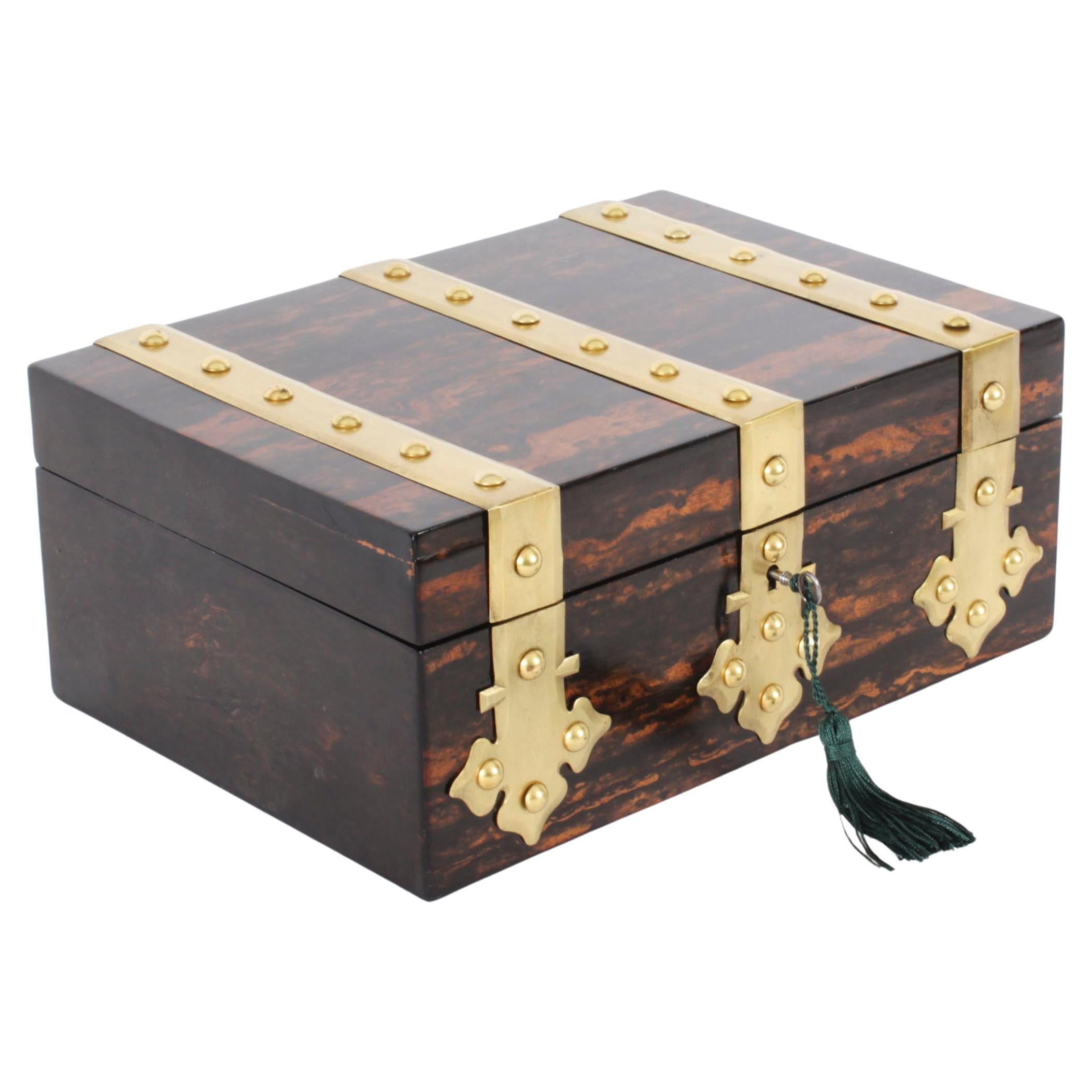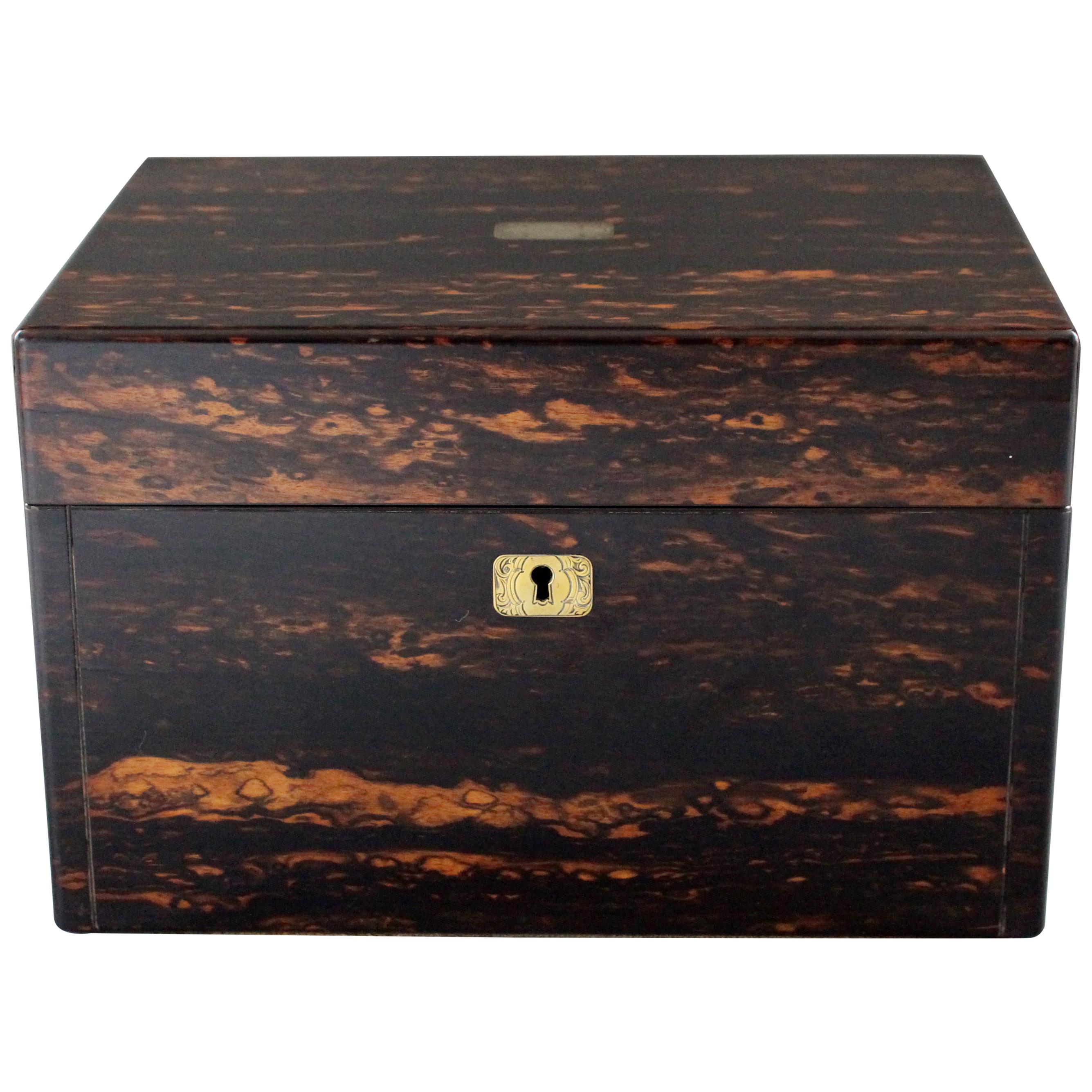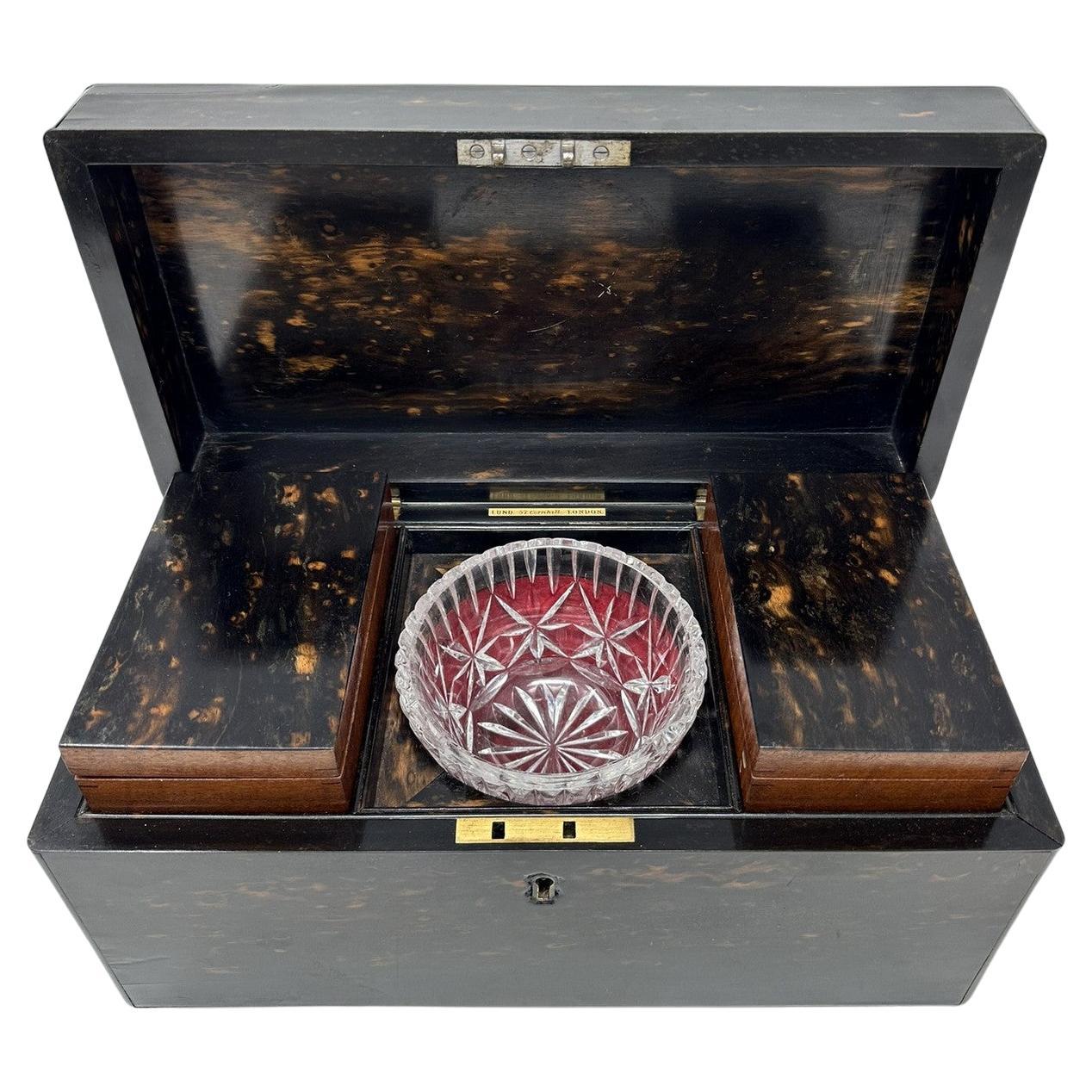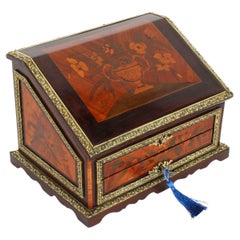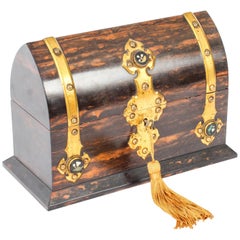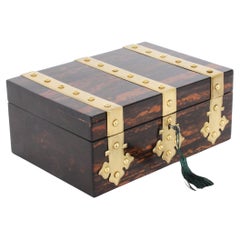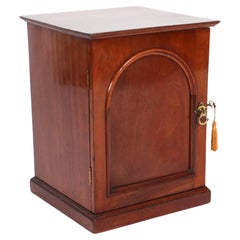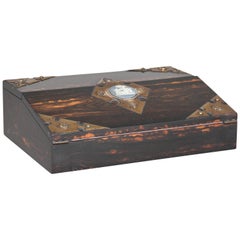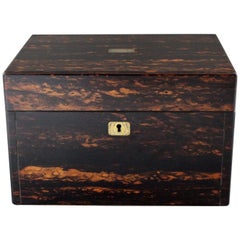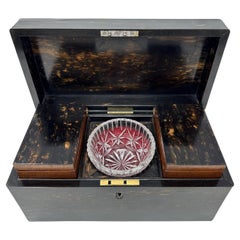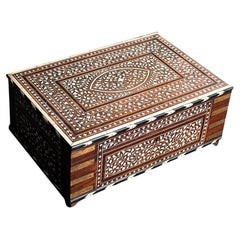Items Similar to Antique Coromandel Writing/ Stationary Cabinet by Houghton and Gunn 19th Century
Video Loading
Want more images or videos?
Request additional images or videos from the seller
1 of 22
Antique Coromandel Writing/ Stationary Cabinet by Houghton and Gunn 19th Century
About the Item
A very fine antique Victorian Coromandel writing or stationary cabinet made by the world famous London box makers and retailers Houghton and Gunn, dated December 1878.
The wonderful antique fall front is centred by a silvered AH monogram beneath a coronet and opening to reveal an arrangement of labelled pigeon holes, a fold out letter rack, small books, and pull out ink and pen compartments.
If features a secret compartment on the right side which can be opened by pulling the right hand side divider, ideal for playing cards and dice.
There is no mistaking its unique quality and design, which is sure to make it a treasured piece by any discerning collector.
Coromandel, also known as Calamander wood, is a higly prized and valuable exotic wood from India and Sri Lanka and was only used in top quality pieces.
Complete with working Bramah lock, the lock is stamped Batson for Henry John & Albert Edward Batson.
It bears both the maker's and the retailer's plaque:
'HOUGHTON & GUN, 162 NEW BOND STREET'
This is centred by a Victorian date 'lozenge' for December 1878
Condition:
In excellent condition having been beautifully cleaned and waxed in our workshops, please see photos for confirmation.
Dimensions in cm:
Height 36 cm x Width 41 cm x Depth 18 cm
Dimensions in inches:
Height 1 foot, 2 inches x Width 1 foot, 4 inches x Depth 7 inches
Houghton & Gunn
William Houghton originally established his business in 1822. By 1841, he was based at 162 Bond Street, London. It wasn’t until 1868 that he went into partnership with Charles Henry Gunn. Known as Houghton & Gunn, the business remained at the same Bond Street address until it was bought out by Asprey (its next door neighbour) in 1906.
Coromandel wood or Calamander wood
is a valuable wood from India, Sri Lanka and South East Asia. It is of a hazel-brown color, with black stripes (or the other way about), very heavy and hard. It is also known as Macassar Ebony or variegated ebony and is closely related to genuine ebony, but is obtained from different species in the same genus; one of these is Diospyros quaesita Thwaites, from Sri Lanka. The name Calamander comes from the local sinhalese name, 'kalu-medhiriya', which means dark chamber; referring to the characteristic ebony black wood.
Coromandel wood has been logged to extinction over the last 2 to 3 hundred years and is no longer available for new work in any quantity. Furniture in coromandel is so expensive and so well looked after that even recycling it is an unlikely source. A substitute, Macassar Ebony, has similar characteristics and to the untrained eye is nearly the same but it lacks the depth of colour seen in genuine Coromandel.
Our reference: A3866
- Creator:William Houghton and Charles Gunn (Author)
- Dimensions:Height: 14.18 in (36 cm)Width: 16.15 in (41 cm)Depth: 7.09 in (18 cm)
- Style:Victorian (In the Style Of)
- Materials and Techniques:
- Period:
- Date of Manufacture:1878
- Condition:
- Seller Location:London, GB
- Reference Number:Seller: A38661stDibs: LU950640723782
About the Seller
5.0
Platinum Seller
Premium sellers with a 4.7+ rating and 24-hour response times
Established in 1983
1stDibs seller since 2012
1,345 sales on 1stDibs
Typical response time: 1 hour
Associations
LAPADA - The Association of Arts & Antiques Dealers
- ShippingRetrieving quote...Shipping from: London, United Kingdom
- Return Policy
Authenticity Guarantee
In the unlikely event there’s an issue with an item’s authenticity, contact us within 1 year for a full refund. DetailsMoney-Back Guarantee
If your item is not as described, is damaged in transit, or does not arrive, contact us within 7 days for a full refund. Details24-Hour Cancellation
You have a 24-hour grace period in which to reconsider your purchase, with no questions asked.Vetted Professional Sellers
Our world-class sellers must adhere to strict standards for service and quality, maintaining the integrity of our listings.Price-Match Guarantee
If you find that a seller listed the same item for a lower price elsewhere, we’ll match it.Trusted Global Delivery
Our best-in-class carrier network provides specialized shipping options worldwide, including custom delivery.More From This Seller
View AllAntique French Marquetry and Ormolu Stationary Casket . 19th Century
Located in London, GB
This is a wonderful antique French Gonçalo Alves marquetry and ormolu mounted casket, circa 1860 in date.
The casket of bureau form has a lift up top and is inlaid with a marquetry ...
Category
Antique 1860s Decorative Boxes
Materials
Ormolu
Antique Coromandel and Brass Mounted Scent Bottle Box, 19th Century
Located in London, GB
This is an antique Victorian Coromandel scent bottle box of domed form with elaborate decorative brass mounts with inset attractive Pietra Dura cabochons, circa 1860 in date.
The domed lid reveals three cut glass bottles with stoppers.
The box has a working lock with key.
Provenance: The Dr. Lawrie Webster Collection of Boxes...
Category
Antique 1860s English Victorian Decorative Boxes
Materials
Brass
Antique Figured Coromandel Brass Box / Casket 19th Century
Located in London, GB
This is a magnificent antique brass bound coromandel Victorian Gothic Revival casket by Parkins and Gotto, 24 & 25 Oxford Street, London, circa 1860...
Category
Antique 1860s English Victorian Decorative Boxes
Materials
Brass
Antique Victorian Table Top Jewellery Collectors Cabinet 19th C
Located in London, GB
This is a elegant Victorian mahogany table top jewellery collectors cabinet, circa 1840 in date.
The cabinet is freestanding, finished all...
Category
Antique 1840s English Victorian Jewelry Boxes
Materials
Mahogany
Antique Victorian Brass Bound Oak Cigar Humidor 19th Century
Located in London, GB
This is a stylish antique Victorian oak brass and cedar lined tabletop cigar humidor circa 1860 in date.
The rectangular box features a lift out tray and adjustable divisions with sunken handles to the sides and a hinged lid with a central brass shield.
Complete with the original Bramah lock and key.
It would make a beautiful gift to any connoisseur of fine cigars.
Condition:
In excellent condition. As an antique items, the humidor shows signs of use commensurate with age, these minor condition issues are mentioned for accuracy and, as seen in the accompanying photographs, it displays beautifully.
Dimensions in cm:
Height 19.5 x Width 44 x Depth 29
Dimensions in inches:
Height 8 inches x Width 1 foot, 5 inches x Depth 11 inches
Humidor
is any kind of box or room with constant humidity that is used to store cigars, cigarettes, orpipe tobacco. For private use, small wooden or acrylic glass humidor boxes for a few dozen cigars are used, while cigar shops may have walk-in humidors.
Humidors can be used to store other goods for which a certain level of humidity is desirable; the Colorado Rockies Major League Baseball team stores game balls in a large humidor at their home stadium, Coors Field, to counteract the effects of Denver's high altitude and generally low humidity. Humidors of all sizes use hygrometers to keep track of the humidity levels.
Classification of humidors
Walk-in humidor - most common in cigar bars or stores. One room is built as or converted to a humidor where all the cigars are stored.
Cabinet humidor - usually placed on the floor as a piece of furniture. Typically holds 1000-5000 cigars.
Table humidor - often quite heavy, though portable in theory, it's usually kept in one location. Capacity ranges from three hundred to a few thousand cigars. It usually comes with a polished wood exterior, marble, leather or combination of exotic elements, and glass top.
Personal humidor - semi-regular cigar smokers will sometimes keep a small humidor in their homes for personal storage, special events, or aesthetic characteristics of the humidor itself . Usually contains 20-75 cigars. This may also be known as a "Desktop Humidor".
Travel humidor - portable and made for carrying cigars enough for the outing or event, usually 2 to 10 cigars.
Oak
is a tree or shrub in the genus Quercus - Latin "oak tree" having approximately 600 extant species. Oak wood has a density of about 0.75 g/cm3, great strength and hardness, and is very resistant to insect and fungal attack because of its high tannin content. It also has very appealing grain markings, particularly when quartersawn. Oak wood is very durable, easy to maintain and resistant to wear and tear which is why it can be easily handed to the next generations if taken well care of.
Oak wood virtually lasts forever and you can still admire oak furniture in museums and palaces even if it was made many centuries ago. Oak has been prized since the Middle Ages for use in interior panelling of prestigious buildings such as the debating chamber of the House of Commons in London and in the construction of fine furniture.
Bramah
is London's oldest security company. Established at 124 Piccadilly, London in 1784, and today based in Marylebone, London and Romford, Essex.
Bramah made their first lock in 1784 and the patent was awarded in 1787. The designer was Joseph Bramah. Joseph Bramah was a leading inventor of the industrial revolution, patenting over 18 new ideas, including a new valve for the water closet (toilet), the hydraulic pump, a fountain pen, and a fire engine.
Bramah also introduced a beer hand pump for use at the bar, to prevent fluid loss when barmen went downstairs to pour a new jug! Due to the quality of his manufacturing, his name became a by-word amongst British Engineers for engineering excellence and many of his inventions are on display in the Science Museum in London. You can find one of his original toilets still working in Osborne House, Queen Victoria's home on the Isle of Wight.
The Bramah lock was unique and advanced property and valuables protection enormously. Indeed it was 50 years ahead of any Chubb lock...
Category
Antique 1860s English Victorian Cigar Boxes and Humidors
Materials
Oak, Cedar
Antique Gilt Bronze Jewellery Casket & Miniature 19th Century
Located in London, GB
This is a beautiful antique gilded ormolu serpentine shaped jewellery casket, Circa 1870 in date.
The top, front, sides and back are beautifully cast and tooled in gilt bronze. The ...
Category
Antique 1870s Jewelry Boxes
Materials
Bronze
You May Also Like
19th Century Coromandel Writing Slope
Located in Martlesham, GB
19th century coromandel writing slope, fabulous quality with brass corners and a central brass diamond with a nice jasperware plaque, there is ...
Category
Antique 1880s English Victorian Decorative Boxes
Materials
Wood
$1,063 Sale Price
20% Off
Late 19th Century Victorian Coromandel Toilet Box
Located in Petworth, West Sussex
A Victorian calamander toilet box with ten silver mounted jars, by William Neal, London, dated 1874. The box with fall front, two drawers and secret drawer,...
Category
Antique Mid-19th Century British High Victorian Decorative Boxes
Materials
Silver
$1,058 Sale Price
37% Off
Antique English Coromandel Wooden Double Tea Caddy by Thomas Lund 19th Century
Located in Dublin, Ireland
A Superb Example of an English Georgian Period Well figured Coromandle Double Interior Section Tea Caddy of flat rectangular outline, generous proportions and outstanding quality, al...
Category
Antique 19th Century English Victorian Tea Caddies
Materials
Crystal, Brass
19th Century Hoshiarpur Inlaid Writing Box
Located in London, GB
19th Century Hoshiarpur Inlaid Writing Box
Quite simply, this is a stunning example of a 19th Century hand crafted Hoshiarpur inlaid writing box. The craftsmanship is quite amazing ...
Category
Antique 1870s Indian Early Victorian Decorative Boxes
Materials
Wood
Victorian Desktop Writing Cabinet in Dark Oak Automatic Tambour, 19th Century
Located in Benalmadena, ES
Antique Victorian desktop writing cabinet made in 19th-century England, crafted in dark oak wood with well-defined grain and original period hardware in silver-toned metal. This is a...
Category
Antique 19th Century Victorian Decorative Boxes
Materials
Metal
$734 Sale Price
20% Off
Antique Victorian Coromandel and Mother of Pearl Writing Slope by Richard Wathew
By Richard Wathew
Located in Northampton, GB
Mother of Pearl Inlay
From our Writing Box collection, we are delighted to offer this Victorian Coromandel and Mother of Pearl Writing Slope by Richard Wathew. The Writing Box of sl...
Category
Antique Mid-19th Century English Early Victorian Decorative Boxes
Materials
Leather, Shell, Wood
Recently Viewed
View AllMore Ways To Browse
Silver Box India
Bond Street
Lock Box Silver
Secret Writing
Victorian Secret
Gun Box
Gunning Box
India Ink Furniture
Antique Stationary
Decorative Guns
Antiques With Secret Compartments
Antique Letter Writing
Wood Dice
Antique Small Open Box Silver
Door Letter Box
Asprey Antique Silver
Calamander Furniture
Antique Letter Rack
